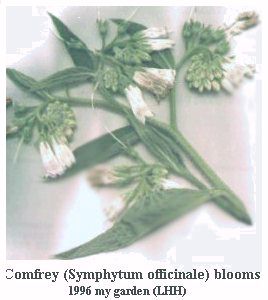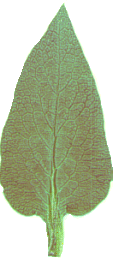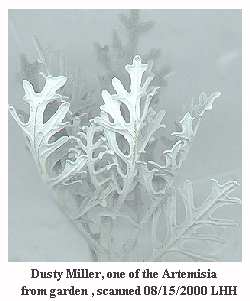
CLEAVERS
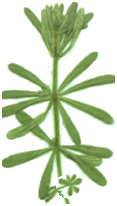 Cleavers, also known as Bedstraw, Galium spp., is a perennial The plant shown at the top of this page is a piece of Cleaver.Cleavers are sticky, not like molasses, little vining plants
that grows wild in most yards that aren't totaly steril and really,
rather a pretty, airy little things. It can't stand up by itself, so it
'cleaves' to what ever is close by. It has another name..can't think of
it right off the top of my head.. later it will come to me. anyway..this
little plant is a good 'greens' vegetable if picked in early spring when
the hairy parts of the leaves have not matured. I am telling you these
wild things, because some day it may save your life! I hope you never
have the need for it, however.
Cleavers, also known as Bedstraw, Galium spp., is a perennial The plant shown at the top of this page is a piece of Cleaver.Cleavers are sticky, not like molasses, little vining plants
that grows wild in most yards that aren't totaly steril and really,
rather a pretty, airy little things. It can't stand up by itself, so it
'cleaves' to what ever is close by. It has another name..can't think of
it right off the top of my head.. later it will come to me. anyway..this
little plant is a good 'greens' vegetable if picked in early spring when
the hairy parts of the leaves have not matured. I am telling you these
wild things, because some day it may save your life! I hope you never
have the need for it, however.
It is neat to be able to use things that our forefathers took for
granted and used each spring.
Mother used to take me, in the early 1930's, to the woodlands and
meadows for 'greens'. It was a delightful trip; learning of the plants
that Nature provided. We'd take brown paper bags and when we got home,
we would have cress, dock, lambs quarter, wild lettuce, dandilion,
sorrels, deer tongue..I can no longer remember all of them but I remember
mother pointing out the ones we didn't gather to eat; butter cups, the
Dutchman's britches, lady's slippers, sweet williams, may apples,
primroses, day flowers, mullien, horse weed, dog fennel, wild oats, poor
man's pepper..you could eat that (poorman's pepper) but we didn't,
except to chew on it a bit just for the heck of it..like chewing on a piece of straw....
She showed me the prickley pears. At that time neither of us thought
about eating prickley pears. She did tell me the Native peoples knew
how to fix them but she didn't. Nopalitos! Check my recipe page and I will get a recipe for nopalitos in ASAP. At this moment my mind is blank..can't remember how to spell it for sure!
Try the cleavers chopped finley in with your spinach or in a salad.
You might like it. Don't cost anything!

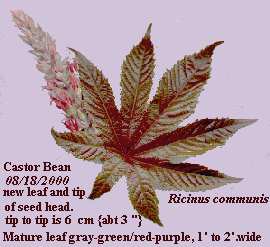
![[image]](pic/rbbar.gif)
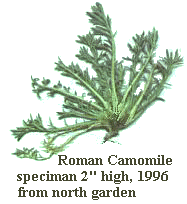 Roman Chamomile
An infant.It will get higher but is a prostrate plant and if kept clipped, it will stay low. The tiny daisy like blooms are born by taller slender stems above the leaves.
Roman Chamomile
An infant.It will get higher but is a prostrate plant and if kept clipped, it will stay low. The tiny daisy like blooms are born by taller slender stems above the leaves.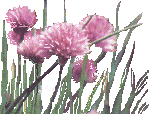 A pot of chives can in the yard or in a sunny window can mean the difference between a plain baked potato or a great baked potato! Chives whether regular Chives as pictured or Vietnamese Chives or Garlic Chives, they are all excellent garnishments for a superior dish. Being of the Allium family, they are also beneficial in that they aid in lowering blood pressure, though not as well as onions.
A pot of chives can in the yard or in a sunny window can mean the difference between a plain baked potato or a great baked potato! Chives whether regular Chives as pictured or Vietnamese Chives or Garlic Chives, they are all excellent garnishments for a superior dish. Being of the Allium family, they are also beneficial in that they aid in lowering blood pressure, though not as well as onions.  Cleavers, also known as Bedstraw, Galium spp., is a perennial The plant shown at the top of this page is a piece of Cleaver.Cleavers are sticky, not like molasses, little vining plants
that grows wild in most yards that aren't totaly steril and really,
rather a pretty, airy little things. It can't stand up by itself, so it
'cleaves' to what ever is close by. It has another name..can't think of
it right off the top of my head.. later it will come to me. anyway..this
little plant is a good 'greens' vegetable if picked in early spring when
the hairy parts of the leaves have not matured. I am telling you these
wild things, because some day it may save your life! I hope you never
have the need for it, however.
Cleavers, also known as Bedstraw, Galium spp., is a perennial The plant shown at the top of this page is a piece of Cleaver.Cleavers are sticky, not like molasses, little vining plants
that grows wild in most yards that aren't totaly steril and really,
rather a pretty, airy little things. It can't stand up by itself, so it
'cleaves' to what ever is close by. It has another name..can't think of
it right off the top of my head.. later it will come to me. anyway..this
little plant is a good 'greens' vegetable if picked in early spring when
the hairy parts of the leaves have not matured. I am telling you these
wild things, because some day it may save your life! I hope you never
have the need for it, however.
